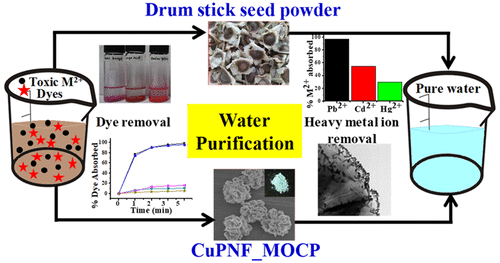当前位置:
X-MOL 学术
›
ACS Sustain. Chem. Eng.
›
论文详情
Our official English website, www.x-mol.net, welcomes your feedback! (Note: you will need to create a separate account there.)
Drum Stick Seed Powder as Smart Material for Water Purification: Role of Moringa oleifera Coagulant Protein-Coated Copper Phosphate Nanoflowers for the Removal of Heavy Toxic Metal Ions and Oxidative Degradation of Dyes from Water
ACS Sustainable Chemistry & Engineering ( IF 8.4 ) Pub Date : 2018-09-18 00:00:00 , DOI: 10.1021/acssuschemeng.8b04138 Sirilata Polepalli 1 , Chebrolu Pulla Rao 1
ACS Sustainable Chemistry & Engineering ( IF 8.4 ) Pub Date : 2018-09-18 00:00:00 , DOI: 10.1021/acssuschemeng.8b04138 Sirilata Polepalli 1 , Chebrolu Pulla Rao 1
Affiliation

|
Seed powder of vegetable drum stick (Moringa oleifera) is a household known material for the coagulation of impurities from water. We find from our lab experiments that this material indeed removes toxic inorganic heavy metal ions and organic dyes; however, the latter can be degraded in the presence of H2O2 under Cu2+ as catalyst. To understand the details of the treatment of water that is taking place by this seed powder, a simple inorganic–protein nanoflower system was developed using copper phosphate (CuP), and a low molecular weight, cationic, and coagulant protein of Moringa oleifera (MOCP), to result in the nanoflowers (NFs), CuPNF_MOCP. The CuPNF_MOCPs were synthesized at different ratios of inorganic versus protein components and characterized by spectroscopy and microscopy techniques. Both the time- and the protein concentration-dependent flower growth showed complete flower morphology within 24 h with tightly packed petals having smooth surface upon increasing the protein concentration as noticed from SEM. The anionic dyes were adsorbed more preferentially over the cationic ones by these NFs, due to the cationic charge present on MOCP, as understood by studying six different dyes of which three are anionic and three are cationic in nature. The dyes are oxidatively degraded by a Fenton-type mechanism that takes place between Cu2+ present in the NFs and added H2O2 with the generation of •OH radicals. These NFs also adsorb heavy metal ions, such as Pb2+, Cd2+, and Hg2+, with high selectivity of >99% for Pb2+. Upon adsorption of Pb2+, the surface of the NFs revealed needle-shaped structures at petal edges in their micrographs, where the needles were confirmed by elemental mapping, powder XRD, and energy dispersive X-ray spectroscopy. Thus, the water purification routinely carried out by the households using the drum stick seed powder is essentially due to the coagulant protein present in it. This has been demonstrated in the form of CuPNF_MOCP for scavenging toxic heavy metal ions and organic dyes from water sources. Hence, this study provides a lead for the purification of water in a sustainable manner.
中文翻译:

鼓棒种子粉作为水净化的智能材料:辣木混凝剂蛋白包被的磷酸铜磷酸盐纳米花在去除重金属离子和氧化染料从水中的降解中的作用
蔬菜鼓棒的种子粉(Moringa oleifera)是一种众所周知的从水中凝结杂质的材料。从实验室实验中我们发现,这种材料确实去除了有毒的无机重金属离子和有机染料。然而,后者可在H 2 O 2存在下,以Cu 2+为催化剂降解。为了了解这种种子粉末对水进行处理的细节,开发了一种简单的无机蛋白质纳米花系统,该系统使用磷酸铜(CuP)以及辣木的低分子量,阳离子和凝结蛋白(MOCP),以产生纳米花(NFs)CuPNF_MOCP。CuPNF_MOCPs以不同比例的无机组分与蛋白质组分合成,并通过光谱学和显微镜技术表征。随时间和蛋白质浓度变化的花朵生长均显示出24 h内完全的花朵形态,随着蛋白质浓度的增加,紧密堆积的花瓣表面光滑,如SEM所示。通过研究六种不同的染料,其中三种是阴离子型,三种是阳离子型,可以理解,由于MOCP上存在阳离子电荷,这些NFs较阳离子型染料更优先吸附阴离子型染料。染料通过Fenton型机理被氧化降解,该机理发生在NFs中存在的Cu 2+和添加的H 2之间带有• OH自由基的O 2。这些NFs还吸附重金属离子,例如Pb 2 +,Cd 2+和Hg 2+,对Pb 2+的选择性高,> 99%。吸附Pb 2+时,NFs的表面在显微照片中的花瓣边缘显示出针状结构,通过元素映射,粉末XRD和能量色散X射线光谱学证实了这些针。因此,家庭通常使用鼓棒种子粉末进行的水净化基本上是由于其中存在的凝结蛋白。已经证明这是CuPNF_MOCP的形式,用于清除水中的有毒重金属离子和有机染料。因此,这项研究为以可持续的方式净化水提供了线索。
更新日期:2018-09-18
中文翻译:

鼓棒种子粉作为水净化的智能材料:辣木混凝剂蛋白包被的磷酸铜磷酸盐纳米花在去除重金属离子和氧化染料从水中的降解中的作用
蔬菜鼓棒的种子粉(Moringa oleifera)是一种众所周知的从水中凝结杂质的材料。从实验室实验中我们发现,这种材料确实去除了有毒的无机重金属离子和有机染料。然而,后者可在H 2 O 2存在下,以Cu 2+为催化剂降解。为了了解这种种子粉末对水进行处理的细节,开发了一种简单的无机蛋白质纳米花系统,该系统使用磷酸铜(CuP)以及辣木的低分子量,阳离子和凝结蛋白(MOCP),以产生纳米花(NFs)CuPNF_MOCP。CuPNF_MOCPs以不同比例的无机组分与蛋白质组分合成,并通过光谱学和显微镜技术表征。随时间和蛋白质浓度变化的花朵生长均显示出24 h内完全的花朵形态,随着蛋白质浓度的增加,紧密堆积的花瓣表面光滑,如SEM所示。通过研究六种不同的染料,其中三种是阴离子型,三种是阳离子型,可以理解,由于MOCP上存在阳离子电荷,这些NFs较阳离子型染料更优先吸附阴离子型染料。染料通过Fenton型机理被氧化降解,该机理发生在NFs中存在的Cu 2+和添加的H 2之间带有• OH自由基的O 2。这些NFs还吸附重金属离子,例如Pb 2 +,Cd 2+和Hg 2+,对Pb 2+的选择性高,> 99%。吸附Pb 2+时,NFs的表面在显微照片中的花瓣边缘显示出针状结构,通过元素映射,粉末XRD和能量色散X射线光谱学证实了这些针。因此,家庭通常使用鼓棒种子粉末进行的水净化基本上是由于其中存在的凝结蛋白。已经证明这是CuPNF_MOCP的形式,用于清除水中的有毒重金属离子和有机染料。因此,这项研究为以可持续的方式净化水提供了线索。


























 京公网安备 11010802027423号
京公网安备 11010802027423号